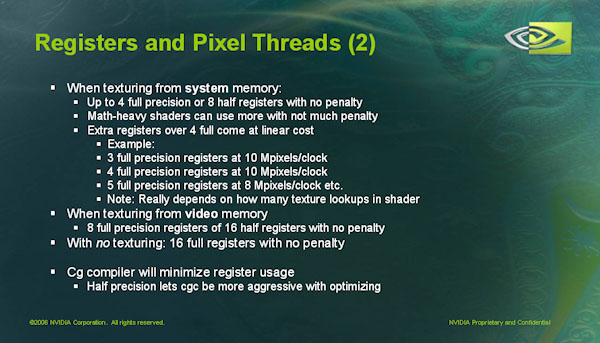deathkiller
Newcomer
Is the RSX capable of transferring VRAM data directly to the local store memory of a SPU?
While I agree with the memory/speed tradeoff in general (i.e. not only for latency hiding et al.), that doesn't change the fact that CPU<-VRAM (read) bandwidth may be valuable, as that was the discussion.
It is not like "Doesn't make sense or you don't need it because you have to have a trade off".
And it's not like the GPU has to make a duplicate "copy" of the data over to VRAM. It can natively read and write to the system RAM with only a small penalty.
Is it that easy? I remember some multiplatform devs saying that they'd have to cut down texture resolutions on PS3 because the system only allows for 256MB of VRAM.
Was that something that has dramatically changed by newer SDKs/firmware updates or is it just an example of "lazy devs" (or is texturing from XDR a totally different thing?)?
You have somehow accidentally fallen into a thread that is discussing that very subject! Start on page 1 and don't stop reading until you get your answer.
I did actually read the thread
Are there any constraints specifically for texturing from XDR like those devs claimed (think it was Ubisoft/SplinterCell)?
If you did, you may have seen a certain slide that answers your question below rather precisely?

Jawed
When you are writing to memory from the CPU you want to write to the fastest memory possible. Remember the Cell is 3.2Ghz and the RSX is only 500mhz. You'd be wasting 6.4x as many CPU cycles compared to the GPU when you are stalled on IO.
Thats why it makes no sense to store your results in VRAM. Store them in XDR, and let the GPU fetch them from there. You would be wasting your CPU time otherwise.
And it's not like the GPU has to make a duplicate "copy" of the data over to VRAM. It can natively read and write to the system RAM with only a small penalty.
No, it doesn'tThe data does have to go VRAM eventually.
No, it doesn't
The cache is given, what's interesting is how much and what kind. I doubt this is written in any public article.If anyone is intrested the confurmation of Cache in the RSX I will see if I can find the article in which it was stated.
Your source as reliable as this manBy the way if anyone should still be interested, the NV2a's (xbox 1) texture cache is 128Kb Lv2 and 8Kb Lv1. And my source is secret but reliable.
Would the fact that the RSX has a cache (read this in a dev interview somewhere) mean that read/writes to XDR, or Cell writes to RSX would help hide latency?
i.e. While the RSX is processing its task the RSX is doing DMA or receiving instructions from SPE's into its cache ready to be acted upon. (I guess this would depend on how big the cache is though.
If anyone is intrested the confurmation of Cache in the RSX I will see if I can find the article in which it was stated.
Your source as reliable as this man
I see this sometime ago (july/2006) from guy seeking information exhaustingly on what would be the RSX :
RSX
Core Frequency - 500MHz
Memory Frequency - 650MHZ
Bus Size: 128BIT
Pixel Shaders - 24
Vertex Shaders - 8
ROPS - 8
Total Texture Cache Per Quad of Pixel Pipes (L1 & L2) - 96KB
Post Transform & Lighting Cache - 63 Max Vertices
*A few extra shader instructions - Extra Texture Lookup Logic & Fast Vector Normalize
*FLEX IO interface to CPU (Much Faster)
7800GTX
Core Frequency - 430
Bus Size: 256BIT
Memory Frequency - 600MHZ
Pixel Shaders - 24
Vertex Shaders - 8
ROPS - 16
Total Texture Cache Per Quad of Pixel Pipes (L1 & L2) - 48KB
Post Transform & Lighting Cache - 45 Max Vertices
PCI BUS interface to CPU (Much Slower)
NOTES: About the RSX.
Total Texture Cache Per Quad of Pixel Pipes - (L1 and L2) 96KB total Texture Cache - Previously 48K
(L1 only available to Pixel Shaders)
Post Transform and Lighting Vertex Cache - 63 Max Vertices - Previously 45 Vertices
(Cache located after Vertex Shader and before the triangle setup and before the Rasterizer.)
Vertex shader --> Post Transform and Lighting Vertex Cache 63MAX ---> Triangle Setup
Texture Lookup Logic to help RSX transport data from XDR
( I have heard this spec fron the others places too ...include here in this forum)
